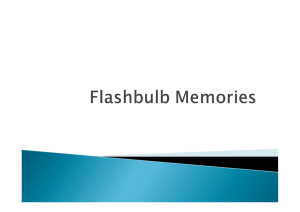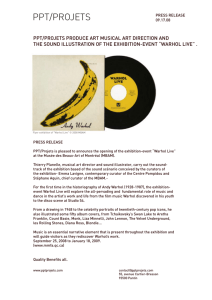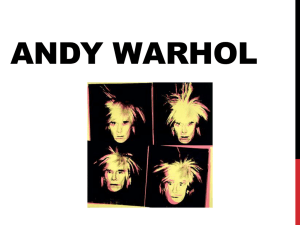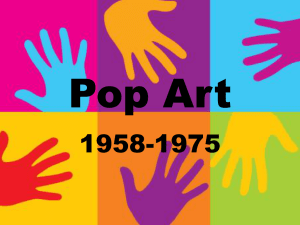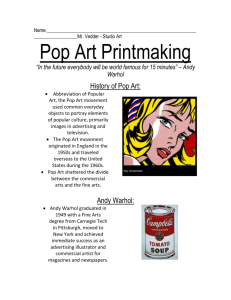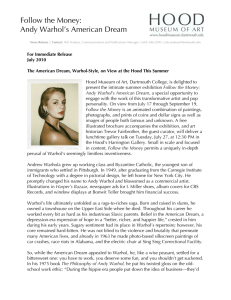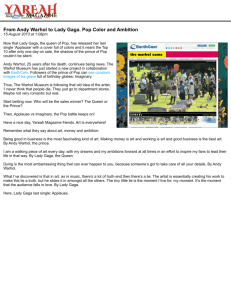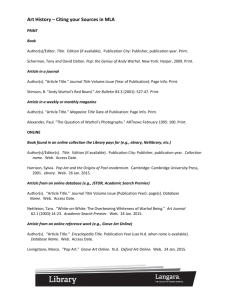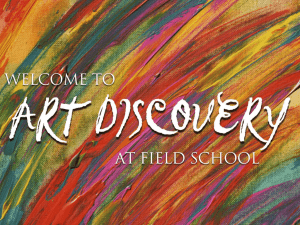andy warhol
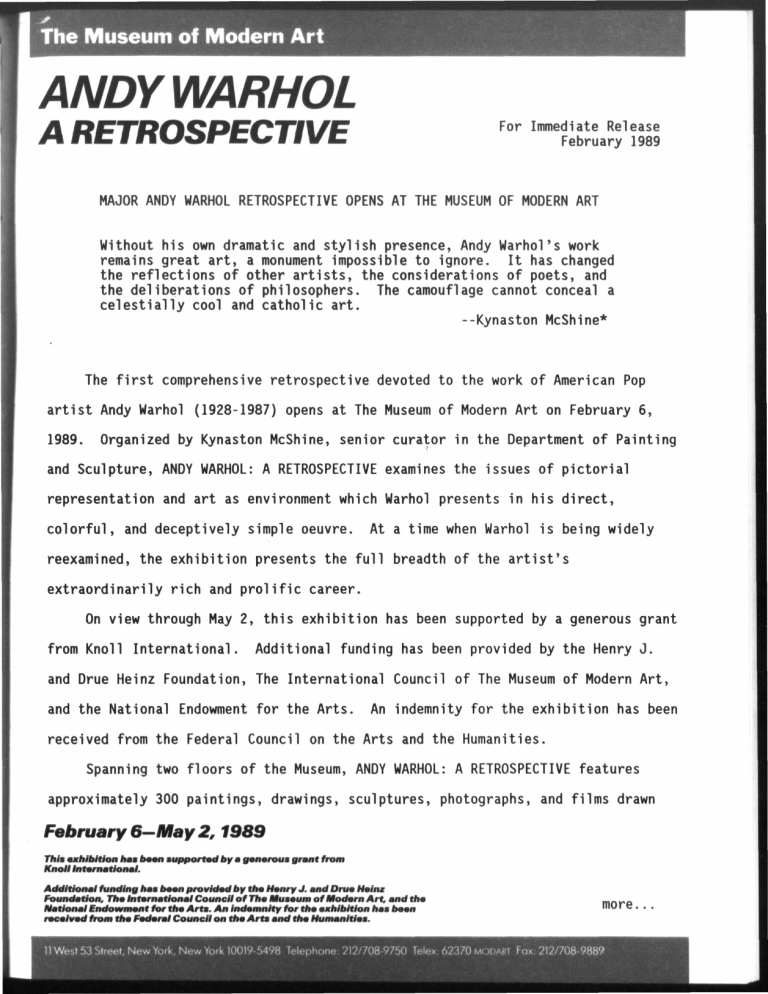
n Art
ANDY WARHOL
A RETROSPECTIVE
For Immediate Release
February 1989
MAJOR ANDY WARHOL RETROSPECTIVE OPENS AT THE MUSEUM OF MODERN ART
Without his own dramatic and stylish presence, Andy Warhol's work remains great art, a monument impossible to ignore. It has changed the reflections of other artists, the considerations of poets, and the deliberations of philosophers. The camouflage cannot conceal a celestially cool and catholic art.
--Kynaston McShine*
The first comprehensive retrospective devoted to the work of American Pop artist Andy Warhol (1928-1987) opens at The Museum of Modern Art on February 6,
1989. Organized by Kynaston McShine, senior curator in the Department of Painting and Sculpture, ANDY WARHOL: A RETROSPECTIVE examines the issues of pictorial representation and art as environment which Warhol presents in his direct, colorful, and deceptively simple oeuvre. At a time when Warhol is being widely reexamined, the exhibition presents the full breadth of the artist's extraordinarily rich and prolific career.
On view through May 2, this exhibition has been supported by a generous grant from Knoll International. Additional funding has been provided by the Henry J. and Drue Heinz Foundation, The International Council of The Museum of Modern Art, and the National Endowment for the Arts. An indemnity for the exhibition has been received from the Federal Council on the Arts and the Humanities.
Spanning two floors of the Museum, ANDY WARHOL: A RETROSPECTIVE features approximately 300 paintings, drawings, sculptures, photographs, and films drawn
February 6—May 2,1989
Thin exhibition has been supported by a generous grant from
Knoll International.
Additional funding has been provided by the Henry J. and Drue Heinz
Foundation, The International Council of The Museum of Modern Art. and the
National Endowment for the Arts. An Indemnity for the exhibition has been received from the Federal Council on the Arts and the Humanities. more
212/708-9889
- 2 from public and private collections in nine countries. Beginning with commercial design work from the fifties, the exhibition includes his early series such as the hand-painted images based on advertisements and comic strips (1960-62); portraits of Marilyn Monroe, Elvis Presley, and Jackie Kennedy, among others (1962-64); the
Disaster images (1962-67); Campbell's soup cans and Brillo, Del Monte, and Heinz boxes (1962-65); Flowers (1964-67); and Mao (1972). More recent series include
Hammer and Sickles, Reversals, Last Suppers, and Camouflages (1985-87). Many of
Warhol's self-portraits--revealing his personal and stylistic evolution over three decades--are also featured.
Warhol began his auspicious career in the late fifties as a distinctive and highly successful New York art director, sketching portraits of friends and creating fanciful designs for shoes and cosmetics. These spare pen-and-ink drawings, some embellished with acrylic washes or gold leaf, provide the basis for what would become the artist's mature style. The retrospective also features an installation reminiscent of a window display Warhol designed for Bonwit Teller in
1961; incorporating paintings of comic strips and newspaper advertisements, this
"exhibition" bridged his commercial and fine-art careers. Most of these early works have never before been exhibited.
Warhol's first Pop paintings of 1960-62 introduce imagery gleaned from the mass media and popular culture, enlarged to monumental proportions. These include works such as Close Cover Before Striking (Pepsi-Cola), a six-foot-high replica of a matchbook cover (complete with flint), and 129 Die in Jet (Plane Crash), a hand-painted recreation of a tabloid front page made more sensational by its mural-like scale. At once deadpan and ironic, they rejected the prevailing post-war traditions of gesture and authenticity esteemed by the Abstract
Expressionists. Prefigured by Marcel Duchamp's Readymades and Jasper Johns's more...
- 3 spare and shockingly simple works ushered in a style and subject matter that would shape the art of the sixties. Art historian Robert Rosenblum writes in the catalogue accompanying the exhibition:
Within this domain, Warhol quickly emerged as a leader, choosing the grittiest, tackiest, and most commonplace facts of visual pollution in America that would make the aesthetes and mythmakers of the fifties cringe in their ivory towers: advertisements for wigs, trusses, nose-jobs, cut-rate appliances; a comic-strip repertory that ran through Superman, Dick Tracy, Nancy, and Popeye; packaged food from . . . supermarket shelves with grass-roots brand names like Campbell*s, Mott's, Kellogg's, Del Monte, Coca-Cola;
American money, postage stamps, and bonus gift stamps; vulgar tabloids (Daily News and New York Post); the most popular stars from James Dean and Elvis Presley to Elizabeth Taylor and Marlon
Brando.
Warhol's unorthodox painting technique is inseparable from his ordinary subject matter. Beginning with the tracings and transfer drawings of his commercial work, he removed himself increasingly from his creations, transferring his ready-made images to canvas using an opaque projector, hand-carved rubber or wooden stamps, and eventually the photosilkscreen method that became his trademark. As the artist recalled, "In August '62 I started doing silkscreens.
The rubber-stamp method I'd been using to repeat images suddenly seemed too homemade; I wanted something stronger that gave more of an assembly-line effect."
This mechanical means achieved the "hands-off" result Warhol desired and allowed for endless duplication of the same image. His first silkscreened paintings, in which airmail stamps, dollar bills, or Coca-Cola bottles are repeated to fill the canvas, introduce the idea of serial repetition that would dominate Warhol's art.
ANDY WARHOL: A RETROSPECTIVE concentrates on the prodigious period from 1962 to 1967, when Warhol exploited the photosilkscreen in a variety of paintings and sculptures. Among the most striking of these is the series Disasters, in which the artist screened multiple images taken from newspaper and wire photos of car crashes, race riots, and atomic bombs over a background of brilliant color. Blue mo re. ..
- 4 -
Electric Chair (1963), for example, juxtaposes fifteen electric chairs with a blank canvas of ultramarine blue in an eerie, numbing diptych. Warhol's celebrity portraits of this period are modern icons, among the most resounding, indelible images of our time. Several versions of them--most notably the renowned
Marilyns--are brought together in the retrospective for a rare demonstration of the artist's obsession with serial repetition. A set of six, six-foot-square self-portraits are also reassembled for the first time since they were commissioned for Montreal's Expo '67.
In 1963 Warhol turned to filmmaking and over the next five years became increasingly preoccupied with the medium. During this hiatus from painting he made more than sixty films, a dozen of which are being shown in conjunction with the exhibition (see enclosed release). Warhol returned to painting in the early seventies with Mao (1972), a series based on the ubiquitous photograph printed in
Chairman Mao's "Little Red Book." Several of these portraits are installed as they were first displayed in Paris in 1974 on a backdrop of Mao wallpaper. Throughout the seventies and early eighties, Warhol continued making portraits of society and art-world figures, experimenting with abstract, gestural backgrounds and the overlay of multicolored camouflage.
Warhol's last works consist of a variety of advertising commissions, print portfolios, and large-scale compilations that incorporate styles and subjects from his early works. In his Retrospective and Reversals series, for example, Marilyn,
Mao, and disaster images recur; in Campbell's soup boxes and Myths, earlier themes are updated to their eighties' equivalents. The exhibition concludes with Last
Supper (1986), a series derived from a dimestore replica of Leonardo da Vinci's masterpiece, and Moonwalk (1987), a print from a proposed History of Television series left unfinished at the time of Warhol's death on February 22, 1987. more...
- 5 -
Following its New York showing, ANDY WARHOL: A RETROSPECTIVE will travel to
The Art Institute of Chicago (June 3 - August 13, 1989); the Hayward Gallery,
London (September - November 1989); The Museum Ludwig, Cologne (November 1989 -
February 1990); Palazzo Reale, Milan (February - May 1990); and Mus6e National d'Art Moderne, Centre Georges Pompidou, Paris (May - August 1990).
* * *
•PUBLICATION Andy Warhol: A Retrospective. Introduction by Kynaston McShine.
Essays by Robert Rosenblum, Benjamin H.D. Buchloh, and Marco
Livingstone. Includes a collective portrait of the artist, with contributions by artists, writers, and other colleagues; chronology; and bibliography. 480 pages. 277 color and 359 black-and-white illustrations. Published by The Museum of Modern
Art. Clothbound volume distributed by Bulfinch Press/Little,
Brown and Company, Boston ($60.00); paperbound available in the
Museum Store only ($35.00).
SYMPOSIUM A symposium entitled "Reflecting on Warhol" will be held in conjunction with the exhibition on Thursday, March 16, at 6:30 p.m. in The Roy and Niuta Titus Theater 1. Moderated by Walter
Hopps, director of the Menil Collection, Houston, the panel includes Trevor Fairbrother, associate curator of contemporary art, Museum of Fine Arts, Boston; Richard Sennett, professor of sociology and University Professor of the Humanities at New York
University; Kenneth Silver, associate professor of fine arts, New
York University; and Amy Taubin, film and television critic, The
Village Voice. Tickets are $8, $7 Museum members, $5 students and are available at the Museum's lobby information desk or by sending a stamped, self-addressed envelope with payment to the
Department of Education.
ADMISSION Admission to ANDY WARHOL: A RETROSPECTIVE is included in the price of regular admission to the Museum; no advance or timed tickets are required. Tickets are sold on a same-day basis at special registers in the Museum lobby to control overcrowding.
For further information, call 212/708-9850.
No. 5
For further information or photographic materials, contact the Department of
Public Information, 212/708-9750.
